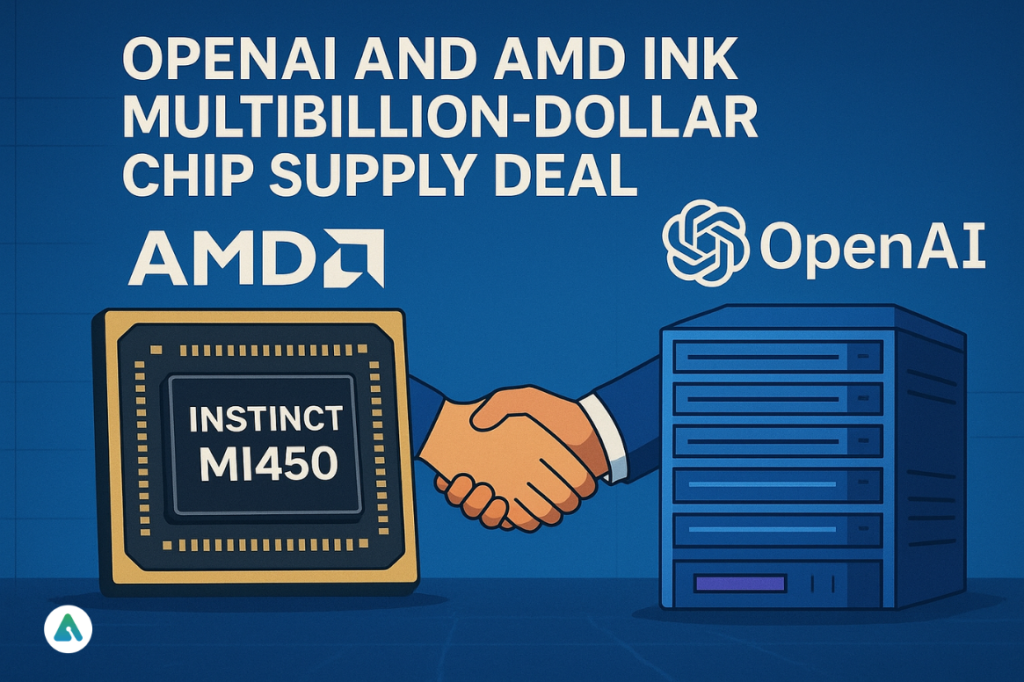In a move that could reshape the global AI infrastructure race, OpenAI and AMD have inked a multibillion-dollar chip supply deal — one that industry insiders are already calling a direct challenge to Nvidia’s near-monopoly on artificial intelligence compute.
The partnership, announced Monday, gives OpenAI access to up to six gigawatts of AMD’s next-generation AI accelerators, starting with the Instinct MI450 series, set to roll out in 2026. The first phase — about one gigawatt of compute — will begin deployment in late 2026, either directly through OpenAI’s data centers or cloud partners such as Microsoft Azure.
But the real headline?
OpenAI now holds the option to buy up to 160 million AMD shares, roughly 10% of the company, at a symbolic $0.01 per share — contingent on AMD hitting performance and stock-price milestones. If that plays out, OpenAI could become one of AMD’s biggest shareholders, aligning the two companies’ fates in the next stage of the AI boom.
Breaking Nvidia’s Grip
For years, Nvidia’s GPUs have been the beating heart of modern AI — from ChatGPT’s earliest training clusters to today’s large-scale inference networks. But as demand for computing skyrockets and chip supply remains tight, AI labs have been forced to diversify.
This deal marks a clear signal of independence: OpenAI isn’t dropping Nvidia, but it’s hedging its future on a dual-supplier strategy — one that gives AMD a long-awaited shot at meaningful AI market share.
“This partnership represents a major expansion of our AI infrastructure,” an OpenAI spokesperson said, adding that “AMD’s performance roadmap and scalability are critical to meeting the growing global demand for inference workloads.”
Inference, Not Just Training
Unlike the enormous clusters that trained GPT-4 and newer models, OpenAI will use AMD chips mainly for AI inference — running and serving models like ChatGPT to millions of users every day. It’s the difference between building the brain and keeping it alive — and experts expect inference demand to outgrow training compute over the next decade.
According to industry analysts, this shift means OpenAI is effectively investing in operational efficiency — optimizing the energy and cost curve for everyday AI usage, not just pushing new model boundaries.
A High-Stakes Financial Play
AMD’s stock jumped more than 25% in pre-market trading following the announcement, as investors cheered what could become the chipmaker’s biggest AI revenue source to date. Analysts estimate the agreement could be worth tens of billions of dollars in total contracts over its duration.
The warrant structure — allowing OpenAI to earn shares as AMD’s performance grows — is a rare financial alignment between a hardware manufacturer and an AI software company. It also gives AMD a massive incentive to hit delivery targets and outperform in the AI sector, where Nvidia still commands nearly 80% of the market.
The Bigger Picture
This isn’t a one-off. It’s part of a larger pattern in AI infrastructure:
-
Compute diversification: Big AI labs no longer want to rely on a single chihttps://en.wikipedia.org/wiki/Hopper_(microarchitecture)p0p vendor.
-
Supply chain resilience: Global demand for AI chips has outstripped capacity — diversification reduces risk.
-
Custom optimization: Companies like OpenAI are seeking chips fine-tuned for inference, latency, and cost — not just raw power.
AMD has trailed Nvidia in AI chips for years, but it’s now seizing the moment to capitalize on its hardware-plus-ecosystem strategy — combining open software frameworks with strong partnerships across major cloud providers.
Execution Will Be Everything
Still, analysts caution that execution risk remains high. Building six gigawatts of compute infrastructure is a monumental task — equivalent to the energy footprint of several small power plants.
Supply chains, manufacturing timelines, and performance parity with Nvidia’s H-series chips will all determine whether AMD can truly deliver.
“OpenAI’s bet on AMD is bold,” said one market analyst. “But bold doesn’t always mean easy. If AMD stumbles on yields or efficiency, the fallback will still be Nvidia.”
The New AI Arms Race
With this partnership, the AI hardware war officially enters its second act. Nvidia defined the first wave of the AI boom — but OpenAI’s latest move signals that the next will be driven by competition, scale, and strategy, not just silicon supremacy.
AMD now holds the opportunity — and the pressure — to prove that it can power the AI systems of the future.
And for OpenAI, the message is clear: the company that builds intelligence needs to own the compute that runs it.
Visit: AIInsightsNews


